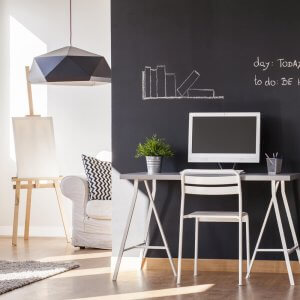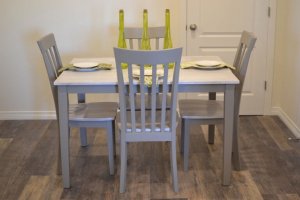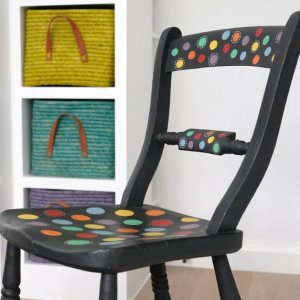Using Chalk Paint to Restore Your Furniture

While the chalk paint technique has been around for decades, it’s become a really popular trend over the last few years. It’s a versatile material, designed to give your furniture a distinctive and original touch.
This type of paint has some interesting advantages over other paints. It’s made of a mixture of acrylic and plaster, which allows it to dry super quickly, and give great coverage.
However, the main advantage of this type of paint is that, in the case of many materials, you don’t have to use a primer or sand the surface before painting. This includes painted or unpainted wood, metal, ceramic, stone, or any other rigid surface.
You can also use chalk paint on smooth surfaces such as glass, plastic or melamine. It has an ultra-matte finish, making it almost velvety to the touch.
Besides its chemical composition, chalk paint also gets its name from the fact that you can draw and write on it once it’s dry as if it were a chalkboard. In this article, we’ll tell you more about the advantages of chalk paint, and how to use it in your home.

Chalk paint is a huge trend among DIY fans. It offers up a huge array of advantages and allows you to restore furniture or any other objects in the blink of an eye.
Chalk paint is easy
This type of paint is extremely easy to use. Anyone can use it, from veteran decorators to the most inexperienced DIY fans. There are several different ways you can apply it, from rollers to brushes or even paint guns. You can also find spray cans of chalk paint.
Toxin-free
Because it’s a water-based paint, it doesn’t contain any kind of solvent and is free from toxins. You can also find eco-friendly certified chalk paint on the market.
Any tools or equipment used to apply chalk paint can be easily washed with a little soap and water, with no need for any specialist cleaning products.
Apply chalk paint directly onto surfaces
When it comes to painting many materials, you can apply chalk paint directly onto the surface (as long as it’s clean). As we already mentioned, another interesting thing about chalk paint is you don’t even need to use a primer first.
For example, if you had an antique piece of furniture with the original paintwork, you wouldn’t need to sand it or take off the old paint. All you’d need to do is clean it and apply the paint.
Mixing colors

Among the many great qualities of this paint is the fact that you can mix it with other shades of chalk paint to create your desired color. You can create almost any color you can imagine.
A little can go a long way
Chalk paint is fairly dense, and one layer is often enough to give full coverage. Just a small amount can be used to cover large surfaces. When it comes to chalk paint, a little can go a long way.
Easy to work with
Thanks to its composition, this paint is quick and easy to work with. It also dries quickly and can be sanded in minutes.
Chalk paint has no smell
Because it’s a water-based paint, it has no smell and can be used to paint your house without leaving behind unpleasant chemical odors that linger for days on end.
If you think it’s necessary, you can apply several coats of paint, always giving each layer plenty of time to dry. In the majority of cases, however, one coat should be enough to give complete coverage and an even finish.
A step-by-step guide to using chalk paint

Step 1
Clean the surface you want to paint thoroughly to remove any dirt.
Step 2
Apply paint directly onto the chosen surface (you shouldn’t need to use a primer). Let it dry for at least one hour.
If the surface you’ve chosen to paint is made of melamine or Formica, we would advise sanding it gently before applying the paint. This will ensure that the paint sticks to it properly.
Step 3
If necessary, you can then apply a second layer of paint.
Step 4
Wait at least 24 hours. You must allow the paint to dry completely before moving on to sanding the surface (using medium or fine grain sandpaper). We’d recommend doing this on any sections where you want to create a faded or aged look.
Step 5
To finish, apply a layer of wax or varnish specially designed for this type of paint. If the object you painted will be used regularly and is likely to get worn out quickly, use varnish instead of wax. The varnish can be applied with a paintbrush.
When it comes to restoring antique furniture, chalk paint is a fantastic option, and we couldn’t recommend it highly enough. You won’t be disappointed with the results.
While the chalk paint technique has been around for decades, it’s become a really popular trend over the last few years. It’s a versatile material, designed to give your furniture a distinctive and original touch.
This type of paint has some interesting advantages over other paints. It’s made of a mixture of acrylic and plaster, which allows it to dry super quickly, and give great coverage.
However, the main advantage of this type of paint is that, in the case of many materials, you don’t have to use a primer or sand the surface before painting. This includes painted or unpainted wood, metal, ceramic, stone, or any other rigid surface.
You can also use chalk paint on smooth surfaces such as glass, plastic or melamine. It has an ultra-matte finish, making it almost velvety to the touch.
Besides its chemical composition, chalk paint also gets its name from the fact that you can draw and write on it once it’s dry as if it were a chalkboard. In this article, we’ll tell you more about the advantages of chalk paint, and how to use it in your home.

Chalk paint is a huge trend among DIY fans. It offers up a huge array of advantages and allows you to restore furniture or any other objects in the blink of an eye.
Chalk paint is easy
This type of paint is extremely easy to use. Anyone can use it, from veteran decorators to the most inexperienced DIY fans. There are several different ways you can apply it, from rollers to brushes or even paint guns. You can also find spray cans of chalk paint.
Toxin-free
Because it’s a water-based paint, it doesn’t contain any kind of solvent and is free from toxins. You can also find eco-friendly certified chalk paint on the market.
Any tools or equipment used to apply chalk paint can be easily washed with a little soap and water, with no need for any specialist cleaning products.
Apply chalk paint directly onto surfaces
When it comes to painting many materials, you can apply chalk paint directly onto the surface (as long as it’s clean). As we already mentioned, another interesting thing about chalk paint is you don’t even need to use a primer first.
For example, if you had an antique piece of furniture with the original paintwork, you wouldn’t need to sand it or take off the old paint. All you’d need to do is clean it and apply the paint.
Mixing colors

Among the many great qualities of this paint is the fact that you can mix it with other shades of chalk paint to create your desired color. You can create almost any color you can imagine.
A little can go a long way
Chalk paint is fairly dense, and one layer is often enough to give full coverage. Just a small amount can be used to cover large surfaces. When it comes to chalk paint, a little can go a long way.
Easy to work with
Thanks to its composition, this paint is quick and easy to work with. It also dries quickly and can be sanded in minutes.
Chalk paint has no smell
Because it’s a water-based paint, it has no smell and can be used to paint your house without leaving behind unpleasant chemical odors that linger for days on end.
If you think it’s necessary, you can apply several coats of paint, always giving each layer plenty of time to dry. In the majority of cases, however, one coat should be enough to give complete coverage and an even finish.
A step-by-step guide to using chalk paint

Step 1
Clean the surface you want to paint thoroughly to remove any dirt.
Step 2
Apply paint directly onto the chosen surface (you shouldn’t need to use a primer). Let it dry for at least one hour.
If the surface you’ve chosen to paint is made of melamine or Formica, we would advise sanding it gently before applying the paint. This will ensure that the paint sticks to it properly.
Step 3
If necessary, you can then apply a second layer of paint.
Step 4
Wait at least 24 hours. You must allow the paint to dry completely before moving on to sanding the surface (using medium or fine grain sandpaper). We’d recommend doing this on any sections where you want to create a faded or aged look.
Step 5
To finish, apply a layer of wax or varnish specially designed for this type of paint. If the object you painted will be used regularly and is likely to get worn out quickly, use varnish instead of wax. The varnish can be applied with a paintbrush.
When it comes to restoring antique furniture, chalk paint is a fantastic option, and we couldn’t recommend it highly enough. You won’t be disappointed with the results.







